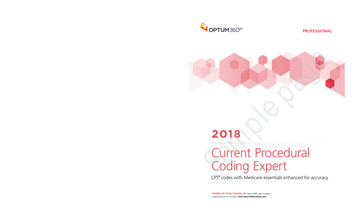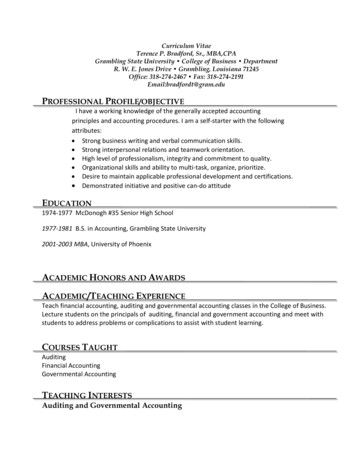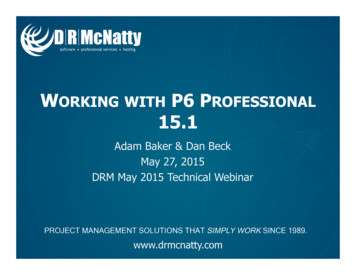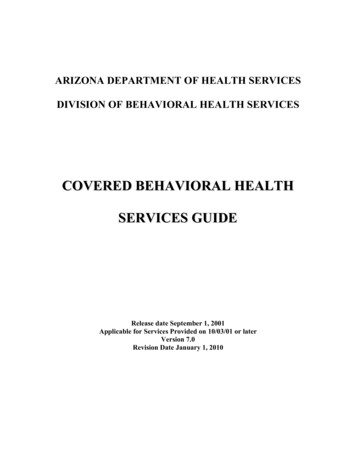
Transcription
PROFESSIONAL SERVICES GUIDE TODCA A ComplianceYour Guide to Efficient and Effective Government Contracting
Table of Contents0 1 DCAA Crash Course04 Principle Do’s and Don’ts05 Strategies for Becoming CompliantBuilding Your Foundation 05Budgeting 07Time Tracking 08Capturing Costs 09Reviews and Approvals 09Presenting Your Audit Trail and Reports 1011Checklist for DCAA CompliantFirm Management Software12About BigTime
About This GuideTackling DCAA regulations canbe daunting. Digesting pages ofdocumentation on complianceis less than thrilling. BigTime iscommitted to relieving the stressinvolved in following GovCon rulesfor professional services firmsof all sizes. To help you becomeacclimated with the process,and put your firm on the track tosuccess, we put together this guide.We’ll walk you through the basicsof DCAA compliance for thosecompletely new to the world ofGovCon. Then, dive into strategiesfor building, or improving yourinternal workflow in a compliant,efficient and effective way.Before you get started, we’d like tonote that while this guide is filledwith many universal DCAA bestpractices and insights, it should beused in partner with the resourcesprovided by the FAR (FederalAcquisition Regulations). Once youhave your bearings, it’s importantto know specifically how DCAA willimpact your firm.
DCA A Crash CourseWHO IS THE DCA A?The Defense Contract Audit Agency (DCAA)performs all contract audits for the United StatesDepartment of Defense. Although it’s a member ofthe Department of Defense, the DCAA also assistsother government agencies with accounting andfinancial advisory services. The goal of the DCAAis to make sure taxpayers and military dollars arebeing spent accurately.Professional Services Guide to DCAA Compliance01
WHAT ARE THE REGUL ATIONS OF DCA A COMPLIANCE?1. Documentation: Formal policy and procedure documents5. Formal Approvals: All submitted timesheets must bedetailing the steps for following DCAA compliance time trackingreviewed and approved by the employee’s supervisor orand accounting must be provided to all employees. Even thoseproject manager, with an electronic signature. Remember forwho are not directly working on a government project must begovernment contractors, all approved timesheets become aaware of the regulations. A formal review of the time trackinglegal document, so reviews are crucial.process is also required annually.2. Daily Time Tracking: All time must be recorded daily for the6. Corrections: Any corrections to incorrectly submittedtimesheets must be fixed by the employee and approvedhighest level of accuracy. Time that is recorded for days past,again by the supervisor. If for unforeseen reasons theand submitted late, is not considered valid or compliant. Trackingemployee cannot make the changes themselves, thentime in advance is also prohibited for holidays and vacations.accounting or the administrator can make the changes,with the employee’s consent.3. All Hours Accounted For: In addition to time being trackeddaily, no work hours can be left undocumented. Every hour7. Save Your Records: All timesheets, financial documents,of the workday must be recorded including any leave timeand a documented trail of actions must be kept for a minimumincluding vacation, holiday or sick days.of three years after the final payment, in case of an audit. It’stypically recommended that you store these files for longer4. Follow Project Codes: Entering time to the right project,than three years.with the correct label, is just as important as the time beingentered. The system administrator or finance team must initiatethe set-up of proper job codes and names, and authorizethe appropriate employees per project. Time spent workingoutside of the dedicated project must also be allocated to theappropriate place rather than left unaccounted for.Professional Services Guide to DCAA Compliance02
WHY IS COMPLIANCE IMPORTANT?Consider following DCAA regulations like a domino effect: the tighter yourworkflow, the more documents you’ll have to prove a strong audit trail, and thebetter results your firm will see. Without the proper workflow, your audit trail willbe filled with holes and gaps that can lead to serious consequences for yourfirm. If you fail an audit, the DCAA can recommend the government group cutoff payments for the current project, and in extreme scenarios, your firm can beplaced on probation or barred from government contracting.Last year, the DCAA examined 281 Billion,and found 7.1 Billion in audit exceptions.WHAT IS THE DCA ALOOKING FOR IN AN AUDIT?The primary purpose of an audit is to checkon the cost of a project. Money spent by thegovernment must be classified differentlythan a standard business may go about theBenefits from following DCAA compliance from the beginning: Reduce the stress placed on your firm if you are selected for an audit Save yourself from spending extra money hiring a last-minute DCAAconsultant to get your firm organized Allow for more strategic decision making on your engagements by keepingmanagement and your client informed throughout the project Expand your firm’s network of business to future GovCon opportunitiesby having the correct process in place to win engagementsProfessional Services Guide to DCAA Compliancepayment for contracted work. Commonthings for the DCAA to inspect include:allowable costs, unallowable costs, directcosts, indirect costs, cost pools and poolingof indirect costs. The compliance processstarts with time tracking but must carrythrough to accounting to prevent any errorsin the complete records. For further detailson the items inspected during an audit, visitthe FAR website.03
Principle Dos and Don’tsDON’T: Put off being compliant with GovCon regulations; it will only createmore work down the line Fall behind, or plot forward, when tracking time to prevent errorsin timesheets Let reviews-and-approvals bottleneck without a streamlined system Make it up as you go; there is too much at stake for your business tonot invest the effort upfrontDO: Be diligent about all staffers keeping track of their time daily Set and track budgets for projects, overall company financials andindirect cost rates Align your accounting system to capture business transactions incompliance with GovCon rules and regulations Stay on top of your audit trail with complete and accurate records Be familiar with the FAR and how it impacts your firm specifically Have a strategic partner to help you set up your internal workflowand ensure everything is up to compliance standardsProfessional Services Guide to DCAA Compliance04
Strategies forBecoming CompliantSTEP 1BUILDING YOUR FOUNDATIONInvest in a sustainable plan for growthEven small firms need to think big when it comes to governmentcontracting. Resist setting up a manual process that may get you by for theinitial process, and think long term. How will the process work in one or fiveyears? Your plan needs to be flexible enough to scale with your business soyou don’t have to keep reinventing your workflow. Start on the right foot byinvesting in software for your time tracking and accounting to ensure yoursuccess remains seamless, with fewer roadblocks.Create documentation for DCAA policies and proceduresHaving a formal policy for DCAA time tracking and building your audittrail is required by the DCAA, along with an accompanying proceduredocument detailing the process. Rather than thinking of this as just anothercompliance step to cross off the list, use the opportunity to get your wholefirm organized. Although some of the compliance rules seem tedious,there’s a lot of good ideas built-in for aligning your time tracking, budgeting,capturing costs and invoicing.Professional Services Guide to DCAA Compliance05
Keep notes as you plan, and enlist the help of a DCAA specialistfrom the beginning to help you build out your own customformula for success. This will save you money down the line ofhaving to hire a last-minute consultant when an audit strikes.Get everyone on the same pageStandardizing your firm’s internal management and time trackingsystem for all employees is the safest route. Even if governmentcontracting is only a branch of your business, you never knowwhen you’ll need to pull in an additional resource, and ultimatelyone process keeps things less complicated and organized.Communication is keyto making the adoptionseamless for everyone inyour organization.Communication is key to making the adoption seamless foreveryone in your organization. Aim to make the transition swiftlyto avoid messy records and overlaps. Change is hard in thebeginning, but everyone will adapt to the new norm with time.It’s human nature to give more care and thought to ouractions if we know the purpose behind them. When trainingTraining your employeesOperations on the needs of DCAA compliance, and staffers onOften the biggest pain point in service firms, and even moretheir time tracking, make sure to communicate the importancecrucial in those who need to be DCAA compliant, is whenof the audit trail. Explain how the regulations impact theOperations doesn’t get Accounting the information they need.way Accounting is able to build your documentation and theMany businesses make the mistake of training their employeespossible consequences that come from failing an audit. Shouldon the processes, but leave out the essential why. Why am Iyou be audited, an auditor can ask employees why they aredoing this? Why is it important? Why were these stepsfollowing the regulations and if they fail to answer, it’s a strikeput it place?against compliance.Professional Services Guide to DCAA Compliance06
STEP 2BUDGETINGSet an overall company-wide budget and separateproject budgetsKnow your staff capacity in detail, and be nimble toreallocate when neededThe driving factor behind the DCAA is budgets̶all the otherAn imperative part of staying on budget is having a clearpieces play into making sure the budget stays on track and isunderstanding of your staff capacity. Documenting your staff-accurately captured. In order to understand the full scope ofmanagement process is not a requirement of the DCAA, but ityour firm’s budgets and current status, it’s important to create anwill help your firm function more efficiently for GovCon projects.overall-company wide budget including labor costs, rent, clientA professional services automation software cuts down on theentertainment, any expense that comes out of the company’stime spent plugging staff hours into an Excel sheet, and meetingpocket. Then, make separate individual budgets specific to eachto go over project plans. Instead, the software shows you inproject. Track your project budgets based on percent complete,real-time how much time is available for each staff member, andor any other mechanism of the contract, and manage the WIPwhat projects their time is currently being allocated to. Fromregularly to make real-time adjustments when needed.there, you can assign tasks, and readjust if needed. Streamliningthis step of your workflow is essential, so you can react quickly,and stay within budget.Don’t wait till the end; pull status reports in real-timefor no surprisesThe more transparent your project status is, the better when itcomes to GovCon. Keep a constant pulse on where your projectbudgets stand, so you can be strategic in how you move forward.If a problem does arise, you’ll be able to inform the client withreal data on what changes need to be made.At the end of the month or quarter, you can then roll up all projectactuals and make sure it’s in line with the company-wide budget.Professional Services Guide to DCAA Compliance07
STEP 3TIME TRACKINGUse calendar reminders to make time trackinga daily habitLook for time-tracking software that’s pre-configuredto DCAA regulationsDiligent time tracking takes practice. Using a calendar reminder, orOne of the safest ways to ensure compliance for your wholeany form of an alert, at the same time each day makes it easier forstaff is to use a time tracking software that is pre-configured tostaffers to remember.DCAA regulations. Not only will this save you from loads of timespent customizing software that wasn’t built for GovCon, but itStraightforward notes requirementswill also simplify the process for everyone on the team.One part of DCAA timekeeping that may be an adjustment forstaff is each entry must include a note. The goal behind this is toAt the end of this guide, we provide a checklist to use whenstrengthen the information stored in the audit trail by providingbrowsing for a time tracking software to ensure you find onefurther details on what the time recorded was spent on. To makestructured best for easy compliance.this task feel less tedious, be clear on what your requirementsare for the notes. Have a formula of what’s expected, that waythe notes are all aligned, beneficial, and hopefully don’t take toomuch time for the staffer.Don’t forget internal projects like holidays,sick days, etc.Make a list of all the non-client-related events during theworkday and set up projects for them. As part of regulations,all hours of the workday must be accounted for, so rather thanleaving a holiday blank, it must be marked as such.NERVOUSABOUTGETTINGYOUREMPLOYEESON BOARD?Time tracking can be one ofthe harder aspects of DCAAcompliance to enforce. Peopleforget, they get lazy.the listgoes on. To encourage staff,reiterate the importance ofcompliance to the success ofthe firm, and include it as part ofOnly give staffers rights to the projects they needtheir performance review. MakeEliminate confusion and prevent mistakes by taking the timeit valuable to them beyond justto customize the projects each staffer has access to in youranother rule to follow.time-tracking software. You’ll thank yourself later with fewertimesheets to correct, and happier staff.Professional Services Guide to DCAA Compliance08
STEP 4STEP 5Capture expenses, labor costs and other billable costsin the same software as you track timeOne person to review and approve per groupAll billable costs must be saved as part of your audit trail, andresponsible for the approval of timesheets in the group. Choosethe easiest way to do this is by having staffers submit expenseseither the project manager or a supervisor, and try to avoidin the same software that they track their time. This way, laborenlisting both of them for the same duty. This takes out one ofcosts and expenses are managed in the same system, and canthe potential bottlenecks to speed up the process, and makes itbe pushed to your accounting system in one sync.easier for the staffer to have one consistent point of contact forCAPTURING COSTSREVIEWS AND APPROVALSLimit the cooks in the kitchen: designate one person who isany corrections that may occur.An added bonus is that working this way will help you bettermanage budgets and build accurate invoices. The fewer parts tomanage, the more effortless your firm will operate.Lock timesheets after submission to eliminatecorrection errorsA big part of following compliance is taking the proper steps toDesign your accounting system to understandyour businessmake corrections so that everything is properly documentedIntegrate your time-tracking, project-management platform withimproper corrections is to lock the timesheet after submission.your accounting system to ensure project names and codes areThis will make sure that the approver is notified of any changesconsistent across the board. When all systems seamlessly talkand enforces the correct communication.with a reason. The simplest way to prevent staffers from makingto each other, it eliminates the hassle of double-data entry foradmins, and cuts down on mistakes.A big part of followingcompliance is taking theproper steps to makecorrections.Professional Services Guide to DCAA ComplianceAutomate review requests and approval confirmationsThe most notorious bottleneck is waiting for things to bereviewed. Cut down on the time spent sending review requests,reminders and approval confirmations by automating thenotifications. Set up your time-tracking software to automaticallynotify the approver once a timesheet or expense report has beensubmitted either within the platform or in their inbox. Letting thesoftware take care of these steps streamlines the workflow andprevents documents from falling through the cracks.09
STEP 6PRESENTING YOUR AUDIT TRAILAND REPORTSUse software that has a robust audit trail tool to ensureeverything is stored with accuracyAudit trails can include timesheets, check deposit receipts, bankstatements.really any source document related to the GovConproject. Being able to trace who did what actions is key. Forexample, who entered what time, or who processed a certaintransaction. Without professional services automation software tocollect this data for you, the manual process to build audit reportscan be strenuous. Having PSA software guarantees your data isstored properly and pulled into the proper reports. That way, youradmin is only responsible for any stray paper documents, ratherthan every document that is processed.Familiarize yourself with the report structureHave a designated audit expert within your firm who is completelycomfortable with the report structure and can speak to it withconfidence. When you know that your firm is just as familiar with itsreports and data as the auditor, you can rest easy.Rely on cloud-based software to store your filesCompliance requires you store your engagement history for threeyears after the final payment, although we would recommend sevenyears for the most complete records. The safest way to keep all thedata is in the cloud. Storing files on a local hard drive or in a printedformat puts them at risk of being damaged, misplaced or lost. This isa risk you can’t afford with DCAA audits.Professional Services Guide to DCAA Compliance10
Checklist forDCAA-Compliant FirmManagement SoftwareDCAA compliance is tricky to navigate withoutthe proper software in place to guide you duringthe process. For companies small and largethat are taking on government work, DCAAcompliant time-tracking software is a must.Working alongside a complaint accounting tool,such as QuickBooks, will put your firm at easewith the assurance you have a solid audit trail.When looking for a DCAA-compliant software,use the following checklist to make sure you’reinvesting in a platform that not only follows theregulations but also makes the process as easyand seamless for your firm as well.Professional Services Guide to DCAA Compliance11
1. Required timesheets fields: Solutions with built-in4. Cloud-based and mobile options: Accessibility is keyDCAA rules will cut out timesheet submission errors, almostfor DCAA-compliant time tracking. For remote or on-site jobs,completely. A DCAA-compliant solution will require the noteshaving a cloud-based solution that can be accessed on anyfield to be completed with every entry of time, and preventbrowser and a mobile app is essential, for on-the-go tracking.users from submitting time for past dates. Only timesheets thatCloud-based software is also the most secure way to ensurehave been completed properly can then move on for review.your timesheets and audit trails are kept safe and protectedThis feature helps everyone at your firm stay accountable forfrom being damaged.the first step of compliance.2. Automated reviews and approvals: Ask the solution5. Efficient workflow for timesheet edits: Look out forcustom user-rights abilities. That way, it ensures each staffprovider about how they automate this process to become anmember is following their correct responsibilities for keepingeasy step, rather than a roadblock. When you have softwarethe timesheet DCAA-approved.that sends automated notifications when a timesheet has beensubmitted, you can reduce the time you spend emailing andsharing files.6. Integrated solution with your accounting software:Having a time-and-billing software that is integrated into youraccounting software is not required by DCAA compliance, but3. Real-time budgeting: Look for a software that lets youtrack budgets at the labor category or CLIN (Contract LineItem Number) level. That way you can set notifications forwill save your firm a lot of time and prevent any data-entryerrors. This will also keep project names and required codesconsistent across every phase of your firm management.project managers, or any specific user when those budgetsare reaching their risk threshold. This type of budget tracking isunique to time-and-billing software that is DCAA compliant.Professional Services Guide to DCAA Compliance12
ABOUTBIGTIMEBigTime takes the guesswork out ofutilization, capacity planning, andproject profitability. Our awardwinning PSA software providesproject planning, budgeting, timeand expense tracking, and invoicing,all backed by uber-cool reportingand analytics.We help accountants, architects,engineers, IT-services firms,and scientific and managementconsultants budget, track and billtheir most important asset: time.Looking to power up yourprofessional services organization?Click the button below to request apersonalized demo.311 South Wacker DriveSuite 2300, Chicago, IL 60606REQUEST DEMO1-866-BIGTIMEbigtime.net 2019 BIGTIME SOFTWARE
Professional Services Guide to DCAA Compliance 02 Documentation: Formal policy and procedure documents detailing the steps for following DCAA compliance time tracking and accounting must be provided to all employees. Even those who are not directly working on a government project must be aware of the regulations. A formal review of the time .










